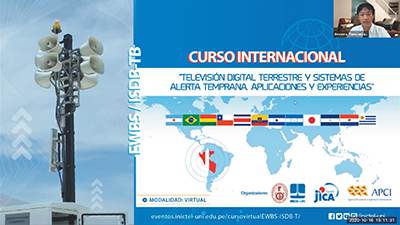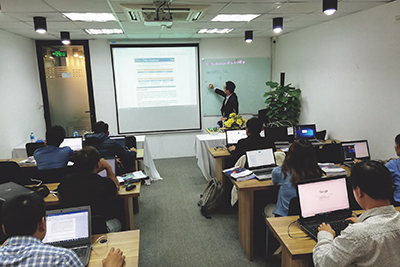(3) Promotion of Information and Communications Technology (ICT), Science, Technology, and Innovation, and Research and Development

A JICA expert giving a lecture at an online training on digital terrestrial broadcasting and Emergency Warning Broadcast Systems (EWBS) for Latin American and Caribbean countries
The dissemination of Information and Communications Technology (ICT) Note 8 contributes to the upgrading of industry, improvement of productivity, and achievement of sustainable economic growth. It also contributes to solving issues of medical care, education, energy, environment, disaster risk reduction, and other areas in developing countries. Furthermore, the utilization of ICT improves their democratic foundation while encouraging information disclosure by governments and establishing broadcasting media. Moreover, the importance of Digital Transformation (DX) Note 9 is increasing under the spread of COVID-19. In this way, ICT is extremely important for strengthening civil society through enhanced convenience and improved services as well as for quality growth.
●Japan’s Efforts
... Information and Communications Technology (ICT)

A Certified Ethical Hacker training underway through the “Project on Capacity Building for Cyber Security in Vietnam” (Photo: JICA)
In 2017, Japan formulated the Playbook for Investment in “Quality ICT Infrastructure” for ICT policymakers and procurement managers of the respective countries and regions in order to promote quality infrastructure investment in the field of ICT, with the aim of eliminating the ICT disparities that exist between countries and regions and helping improve the quality of life of all people.
Moreover, Japan actively offers assistance centered on the establishment of communications and broadcasting equipment and facilities in developing countries, the introduction of the technology and systems they require, and relevant human resources development. Specifically, Japan makes proactive efforts to provide comprehensive support in the areas of maintenance, personnel, and systems for the overseas promotion of Integrated Services Digital Broadcasting-Terrestrial (ISDB-T)*, which is also an effective means for boosting Japan’s economic growth. ISDB-T is being spread in Latin America and the Caribbean, Asia, and Africa, and Angola also decided to adopt it in March 2019. As of December 2019, it has been adopted in a total of 20 countries Note 10. A JICA training program is conducted every year for countries adopting or considering ISDB-T to promote the spread and introduction of ISDB-T overseas. In order to increase the adoption of ISDB-T in other countries, the Ministry of Internal Affairs and Communications (MIC) is also promoting assistance that offers ICT solutions to resolve social issues by way of dialogues and joint projects with partner governments.
In the ASEAN region, Japan is providing low-cost, high-speed internet connectivity for remote locations in island countries, focusing on Indonesia and the Philippines. In the Asia-Pacific region, where over two billion people do not have internet access due to factors including fragile infrastructure and the inability to afford it, Japan has provided loans of $25 million under the Initiative on Overseas Loans and Investments for ASEAN (see also “Project Introduction Column”) to establish low-cost, high-speed internet connectivity.
Japan also contributes in the field of overseas deployment of ICT for disaster risk reduction. Japan’s ICT for disaster risk reduction makes it possible to collect, analyze, and distribute disaster information in an integrated manner, allowing detailed information to be communicated swiftly and infallibly at the community level. Japan will continue to cooperate in the field of overseas deployment of ICT for disaster risk reduction and thereby aim to contribute to increasing the disaster reduction capabilities of developing countries (see Cooperation in Disaster Risk Reduction for more information on disaster risk reduction).
In addition, Japan actively carries out projects in collaboration with international organizations. Japan works with the International Telecommunication Union (ITU)*, a specialized UN agency that is responsible for telecommunications and ICT, to provide a variety of development assistance in the fields of telecommunications and ICT to developing countries.
In October 2020, under the spread of COVID-19, the MIC and ITU began a joint project to support the drafting of national strategies for strengthening digital infrastructure and improving their usage environments, which contribute to suppressing the spread of the disease, with a primary focus on African countries. Saudi Arabia has also joined the project, and together with MIC and ITU, the three will collaborate in advancing the project.
In the Asia-Pacific region, the Asia-Pacific Telecommunity (APT)*, an international organization specialized in the field of ICT, contributes to the balanced development of the telecommunication services and information infrastructure in the region. The triennial APT General Assembly was held virtually in 2020 with Japan acting as chair. In addition to deliberating and deciding on the APT’s strategic plans and budgets for 2021 to 2023, elections were also held for the next Secretary General and Deputy Secretary General, with Mr. KONDO Masanori elected as the Secretary General.
In order to promote human resources development related to telecommunications, which is one of the main objectives of APT’s activities, Japan finances a number of training programs conducted by APT every year. In FY2019, five training programs regarding issues such as broadband networks and cybersecurity were implemented and attended by approximately 50 people from the member states. During the programs, the trainees studied Japanese technology through classroom learning and facility visits and are now utilizing this experience for the development of their own countries’ ICT. In addition, Japanese companies’ expansion into the Asia-Pacific region is also expected through introducing Japanese technology systems in the region.
Furthermore, in ASEAN, ICT was identified as a key driver in ASEAN’s economic and social transformation under the blueprints adopted at the ASEAN Summit in November 2015 that provide new indicators leading up to 2025. Also, at the ASEAN Telecommunications and Information Technology Ministers (TELMIN) Meeting held in the same month, the “ASEAN ICT Masterplan 2020 (AIM2020)” that serves as ASEAN’s ICT strategy toward 2020 was formulated. Moreover, with regard to the issues of cyber-attacks that have become key concerns of countries in recent years, Japan and ASEAN have agreed to further strengthen their cooperation in the information security field.
Based on the “Basic Policy to Support Cybersecurity Capacity Building in Developing Countries” reported to the Cybersecurity Strategic Headquarters in 2016, Japan has implemented initiatives including the establishment of the “ASEAN-Japan Cybersecurity Capacity Building Centre (AJCCBC)” (see Cyberspace for details) through the Japan-ASEAN Integration Fund (JAIF)* and a training program for cybersecurity in January 2020 based on the Japan-ASEAN Technical Cooperation Agreement (see “Project Introduction Column” for details).
... Promoting Science, Technology and Innovation, and Research and Development

Screening bats captured at night in the “Project for Epidemiology of Zoonotic Virus Infections in Africa” conducted in Zambia under the SATREPS program (Photo: Hokkaido University) (see also “Master Techniques from Japan to the World”)
The Science and Technology Research Partnership for Sustainable Development (SATREPS) program*, which links ODA and the science and technology budget, was launched in 2008 as a major program for Japan’s science and technology-related assistance. 157 joint research projects in 52 countries around the world have been adopted by FY2020 (see also “Master Techniques from Japan to the World”).
Furthermore, based on cooperation for human resources, Japan is developing networks among the next generation by strengthening assistance for overseas engineering universities.
In Asia, Japan provides support to the Malaysia-Japan International Institute of Technology (MJIIT) by purchasing equipment and supplies for education and research as well as developing curriculums. Japan also collaborates with 27 universities and two research organizations in Japan to extend cooperation for establishing curriculums, dispatching Japanese faculty, and other objectives. Furthermore, Japan provides contributions to the Asian Institute of Technology (AIT) located in Thailand, one of the Asia’s leading graduate schools offering master’s and Ph.D. programs at the School of Engineering and Technology, the School of Environment, Resources and Development, and other faculties. In particular, Japan is providing scholarships to students studying remote sensing (satellite image analysis) in courses taught by Japanese instructors, contributing to the development of the human resources who will constitute the crux of the space industry development in the Asian region.
In Egypt, Japan continues to support the Egypt-Japan University of Science and Technology (E-JUST), a public university based on the concept of providing graduate school, research-centered, pragmatic, and international-standard education for a small number of students, drawing on the features of Japanese-style engineering graduate school education. With the cooperation from universities in Japan, in addition to providing support for the operation of graduate schools and departments, such as the introduction of practical engineering education and Japanese-style research-centric education, Japan also supports the acceptance of exchange students from African countries, contributing to industrial and science and technology human resources development in Africa and the Middle East.
Glossary
- *Heavily Indebted Poor Countries (HIPCs)
- 39 developing countries, mainly from the Africa and East Asia regions, that are poor and have heavy debt burdens, and that are applicable for the Enhanced HIPC Initiative, a framework to provide comprehensive debt relief.
- *Integrated Services Digital Broadcasting – Terrestrial (ISDB-T)
- ISDB-T is a terrestrial digital broadcasting system that was developed in Japan. Its functions, such as emergency alert broadcast, TV reception on mobile terminals, and data broadcasting, give the system advantages in disaster response and the provision of diverse services.
- *International Telecommunication Union (ITU)
- ITU is a UN specialized agency, which covers the fields of telecommunications and broadcasting (HQ: Geneva, Switzerland; 193 member states). To ensure that people around the world are able to make use of telecommunications technologies, ITU organizes the following: (i) international allocation of radio frequencies used in mobile phones, satellite broadcasting, and other technologies, (ii) international standardization of telecommunications technologies, and (iii) support for development in the field of telecommunications in developing countries.
- *Asia-Pacific Telecommunity (APT)
- APT is an international telecommunication organization established in the Asia-Pacific region in 1979, made up of 38 member states in the region. Aiming for a balanced development of telecommunication services and information infrastructure in the Asia-Pacific region, it implements human resources development through training courses and seminars, and coordinates regional policies on standardization, wireless communications, and other telecommunication issues.
- *Japan-ASEAN Integration Fund (JAIF)
- A fund established in 2006 based on the pledge of then Prime Minister Koizumi at the Japan-ASEAN Summit Meeting in December 2005 to contribute a total of ¥7.5 billion (approximately $70.1 million) to support ASEAN countries’ endeavors to advance integration by correcting regional disparities and aiming at the establishment of an ASEAN Community. Later, at the ASEAN-Japan Commemorative Summit Meeting in 2013, in addition to releasing the “Vision Statement on ASEAN-Japan Friendship and Cooperation” and its Implementation Plan, then Prime Minister Abe announced a contribution totaling $100 million to the JAIF 2.0, expected to be used to realize the Vision Statement and its Implementation Plan (revised in 2017) with four main priority areas: (i) maritime cooperation, (ii) cooperation for disaster management, (iii) counter-terrorism and cybercrime, and (iv) strengthening ASEAN connectivity. Japan provided additional contributions in 2019 as well as 2020.
- *Science and Technology Research Partnership for Sustainable Development (SATREPS) program
→ See also “Master Techniques from Japan to the World” - Through the collaboration of Japan’s advanced science and technology and ODA, SATREPS is an initiative to conduct research to solve global issues relating to the environment and energy, bio-resources, disaster prevention and mitigation, and infectious diseases. Under this program, research institutes both in developing countries and Japan work together to conduct international joint research with the following objectives: (i) strengthening international science and technology cooperation, (ii) acquiring new expertise and technologies that will lead to resolving global issues, and using these to create innovation, and (iii) capacity development Note 11. The Ministry of Foreign Affairs (MOFA) and JICA, in collaboration with the Ministry of Education, Culture, Sports, Science and Technology (MEXT), the Japan Science and Technology Agency (JST), and the Japan Agency for Medical Research and Development (AMED), provide support to research institutes and researchers in Japan and the developing countries.
- Note 8: ICT is an abbreviation for Information and Communications Technology. It is a technology that integrates computers and other information technology with digital communication technology, as represented by the Internet and mobile phones.
- Note 9: Making people’s lives more convenient and enriching them through the introduction of new information technologies, and generating new value by recreating existing business structures with the introduction of new digital technologies, etc.
- Note 10: The 20 countries are Japan, Brazil, Peru, Argentina, Chile, Venezuela, Ecuador, Costa Rica, Paraguay, the Philippines, Bolivia, Uruguay, Botswana, Guatemala, Honduras, Maldives, Sri Lanka, Nicaragua, El Salvador, and Angola (as of December 2019).
- Note 11: Enhancing the independent research and development capacity, building sustainable activity systems which contribute to resolving challenges of developing countries, as well as conducting human resources development and establishing networks between Japan and developing countries for the future through international joint research.
